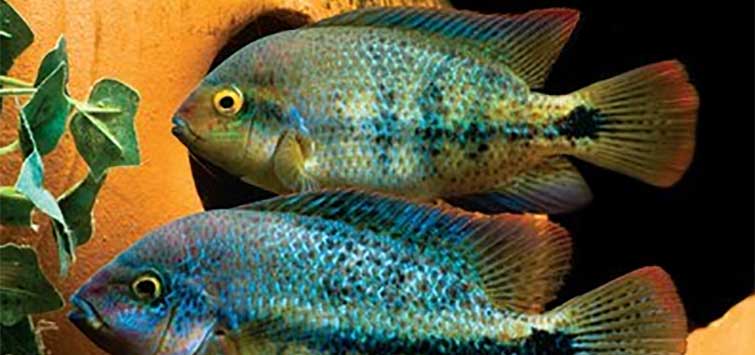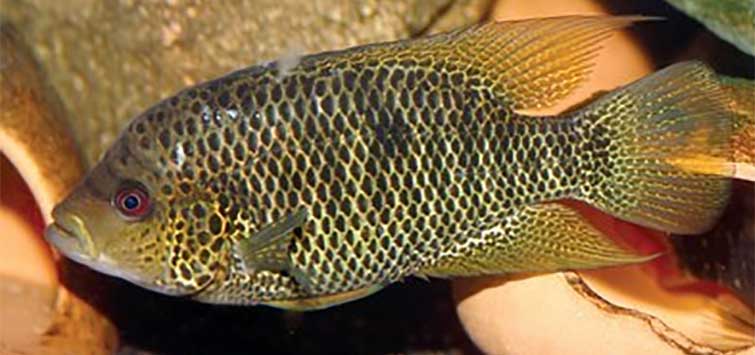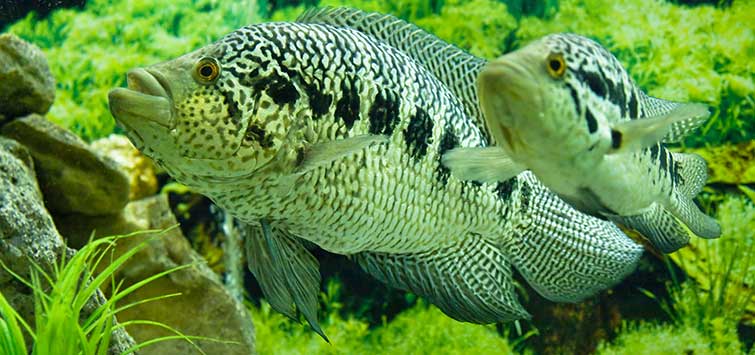Paratheraps sp. "Coatzacoalcos"
Author: Mo Devlin
A stunning cichlid with an engaging personality and a feisty temperament, Paratheraps sp. "Coatzacoalcos" is sure to become a favorite of monster fishkeepers.
Cichlid Collecting with Rusty
Many of my Central American cichlids are wild caught. I either collected them myself or acquired them through friends. I've been very fortunate that my circle of acquaintances includes some well-known aquarists who have traveled the globe collecting and exploring. One such friend is Rusty Wessel. Rusty is well known to many in the hobby, and I have been fortunate to go on several collecting trips in his company. His knowledge and experience have made for many memorable adventures and stories. My acquisition of the very beautiful Paratheraps sp. "Coatzacoalcos" is one of them, but not one that originated in the field.
At the 2010 American Cichlid Association (ACA) Convention in Milwaukee, Wisconsin, Rusty said he brought along some "coatz" for my collection. I said, "Great. Let's go get them." As luck would have it, at that very moment, we were hit with a severe storm warning for a possible tornado. The alarm in the hotel was sounding, and everyone was headed for the storm shelter—except Rusty and me, that is. We were headed in the opposite direction, against the flow of traffic, back to his room where I was going to collect my fish. As we walked back and the storm raged, windows were rattling violently along the hallway. For a fleeting moment, I wondered if I would be swept up and sucked out a window only to be found a half mile away in a field with a bag of fish in my hand. It's the only fish I ever obtained in the midst of a tornado.
A Remote, Rare Cichlid
The name “Coatzacoalcos” refers to the range of species in the Coatzacoalcos River system in the Isthmus of Tehuantepec in Mexico. The fish has not been officially described. It is often confused with P. zonatus, another very beautiful blue fish, and mistakenly sold as "red-tail zonatus" due to the coloration in the caudal fin. In fact, many who think they have zonatus are likely to have one of the local variations of P. sp. “Coatzacoalcos.”
The species in my tank is a variant collected in the Rio Carolina. This river is quite isolated and somewhat remote from the larger populations that exist in most of Mexico. Also inhabiting the Rio Carolina are Vieja regani, Paraneetroplus bulleri, Thorichthys sp.“mixteco,” and T. callolepis.
Color Differences
As you would imagine, various collection locales will produce similar species of fish with a variety of color differences. Coatzacoalcos is no different, even within siblings from the same area. As my fish matured, I noted that one in particular was much larger and had more blue color that was more intense than the others. I automatically assumed that it was a male and the rest were female. I later found out that I actually had two or three other males. Interestingly, while these were more colorful than the normally drab females, they did not present the overall striking blue of the initial male. After inquiring with some other aquarists online, I discovered that it wasn't unusual to have one or two fish with dramatically different coloration. Perhaps it is a dominance indicator. I don't know for sure. The female fish, while not as colorful, still present very interesting patterns.
Spawning Paratheraps sp. "Coatzacoalcos"
Spawning pairs in the wild generally have a bright yellow coloration. Unfortunately, this has not happened in my aquariums. From what I have gathered through other people’s experiences, this is not uncommon. Like most of the Central American cichlids, breeding brings out not only the color but the behaviors that make keeping and photographing them interesting and fun. The coatz were no exception, offering a dramatic switch from solids to strong vertical barring on a high-contrasting background.
Aggression and Breeding
One thing you can always count on with Central American cichlids is that their aggression is always there and never more visible than during the breeding process. When Rusty gave me the fish, the one piece of advice he imparted was that "when these fish pair, you have to separate the pair because they will kill the other fish in the tank." And he was spot on. I had separated the dozen fish I had into three separate 125-gallon tanks. Shortly after the fish reached a length of 4 inches, a pair formed in one of the tanks. As these things often do, it happened when I wasn't in front of the tank. The result was a tank that went from a population of four to two—a male and female. After a few successful spawnings while they were juveniles, the male turned on the female. Now the tank had a population of one.
I'm very familiar with large aggressive fish and the challenges that come with breeding. Several years ago, I designed a very good divider for protecting breeding fish from mutual aggression. Under normal circumstances, I would keep the tank divided and allow a passage for the female to access the male's side. Because there is little difference in the size between the male and female in one of my other tanks right now, I opted for the next best thing. Even though the pair bred once or twice successfully while much younger, I thought it necessary to install a complete divider just to be safe. The female immediately started cleaning a breeding area in an upturned pot next to the divider. The male remained attentive. As has happened many times in the past, the pair will have no problem breeding through the divider.
Picture Perfect Coatzacoalcos
One of my long-standing rules in the fishroom is that if the fish aren’t breeding or posing for the camera, they're moved out of their home for fish that will. These lovely Paratheraps sp. “Coatzacoalcos" never fail to provide me with plenty of quality photos and lots of fry for distribution in the hobby. If you would like to see more photos of this fish, you can visit my gallery at http://goo.gl/LMYFE or visit the Aquamojo Facebook page. As always, if you have any questions or comments, you can email me at aquamojo@modevlin.com. Enjoy the hobby!
See the full article on TFH Digital http://www.tfhdigital.com/tfh/201207#pg59

.png?h=595&iar=0&w=2781&hash=5FD5E69473BCC22199FBFA2FB71B6033)



